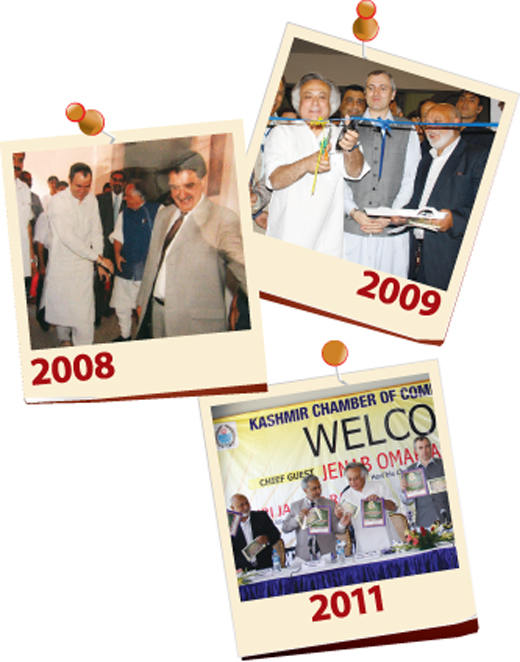Handicrafts have been the main movers of Kashmir economy for centuries. The industry has survived through Kashmir’s troublesome history, but now might need more pragmatic interventions to fit it in the modern economy. Kashmir Life presents a snippet.
 Handicrafts have been the main movers of Kashmir economy for centuries. The industry has survived through Kashmir’s troublesome history, but now might need more pragmatic interventions to fit it in the modern economy. Kashmir Life presents a snippet.
Handicrafts have been the main movers of Kashmir economy for centuries. The industry has survived through Kashmir’s troublesome history, but now might need more pragmatic interventions to fit it in the modern economy. Kashmir Life presents a snippet.
For the last few years, the buyer-seller meeting is gradually emerging as a sort of festival for the Kashmir handicrafts. It will take some more time to mature and grow, but the event is offering sellers, artisans and buyers a chance to interact, exchange ideas and explore possibilities of symbiotic relationships.
The Kashmir artisans and the end users of their produce scattered across the globe have historic bonds spanning many centuries. At one point of time a Kashmiri artisan would decide the bride’s trousseau in West and the cupboard of queens. But quite rarely have they interacted, apparently for reasons of geography and resources. New initiatives and technologies are helping the two reduce the gaps and the buyer-seller meeting is one way of getting the two closer.
There have been numerous incidents in the distant and recent history that impacted the trade. The most recent is the political turmoil that hit Kashmir in 1990. It created a situation that most of the exporters and a section of the producers migrated out for some time. A number of artisans were devoured by the crisis disrupting the trade badly. Now most of the artisans have returned, so have the exporters and the suppliers. Even the more recent economic crisis in most of the Western markets created a glut in Kashmir besides blocking a lot of capital at various channels of the market. The situation is now improving again.
Kashmir has a number of smaller economies in agriculture, horticulture, forests and minerals besides tourism. But neither of those economies can match handicrafts. It is not the turnover of the handicrafts but the sector’s close linkage with rest of the spheres of life that makes it so.
Artisans here weaved shawls and carpets but remained responsive to the situations on the streets. One of the world’s oldest labour protests took place in Kashmir and they were the craftsmen seeking adequate wages. Regardless of how the despots suppressed that agitation, it sowed the seeds of a struggle that later helped throw the monarchy out of Kashmir.
Handicrafts were the main movers and shakers of the Kashmir economy and instrumental in deciding the class and geographic mobility of its people. Before the new political geography barricaded most of the trade routes including access to Silk Route, Kashmiris were running and owning vast market chains in the central Asian republics, mostly selling handicrafts. From the Kashmiri-Tibetans of Lhasa to the Arguans of Leh, it was the handicrafts that impacted the demography of Kashmir and the places en-route the market and the markets themselves.
These handicrafts have led to many small battles in the region. Mughals sent a huge army to help the Ladakh king fight the Tibetan army in 1680s. The only motivation was that Ladakh takeover by Tibet would make Kashmir lose its handicrafts clout.
Even before the British sold Kashmir to a autocrat in 1846, the Jammu durbar in 1834 conquered Ladakh simply because it was not happy with the East India Company making inroads into the central Asian market through Ladakh. The arid region being at the main route for the movement of raw material as well as for finished handicraft goods to Kashmir was a prosperous entity and that was another factor for its fall into the lap of Dogra autocracy. Later the Maharaja invested substantially to ensure the pony track from Srinagar to Leh remains undisturbed and use worthy most of the summer. The Maharaja’s kitty would usually be filled by the exploitative taxation on the handicrafts, mostly the shawl. By and large it was the same system in vogue for nearly a century when most of the earnings on the handicraft front would go to the Maharaja’s treasure.
These are the main factors making handicrafts a different player in the economics of Kashmir. This comparatively disorganized sector continues to be a major player in the economy despite the challenges it is confronted with – the fake machine made brands being used and sold freely and the failure of the system in implementing various protection mechanisms already on the statute books.
But the sector involving more than 374 thousand artisans across Kashmir needs to be taken seriously. There are various initiatives in place and a number of actors contributing towards the well being of the sector for diverse reasons. But the major issue that would require immediate attention is to protect the artisan pool, some of whom are keen to switch over to other occupations.
The second vital priority for the trade and the government must be helping artisans to improve the designing part so that it suits the new age user. And finally, the forward linkages of the trade may require a better model in which the marketing and financing parts are made two separate exercises.













